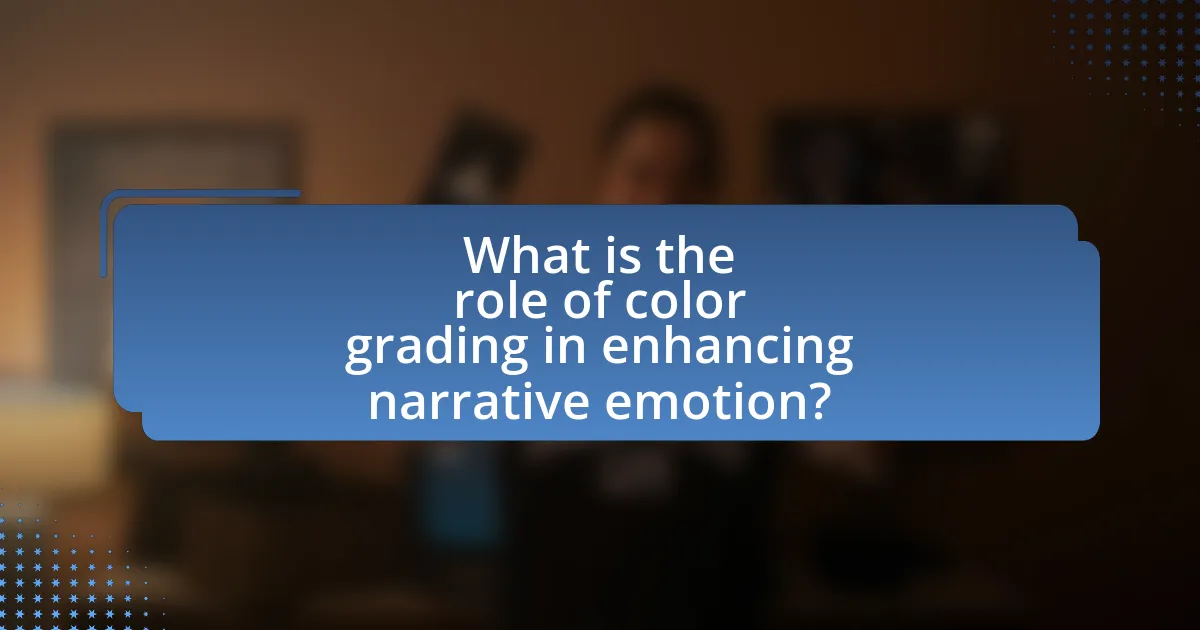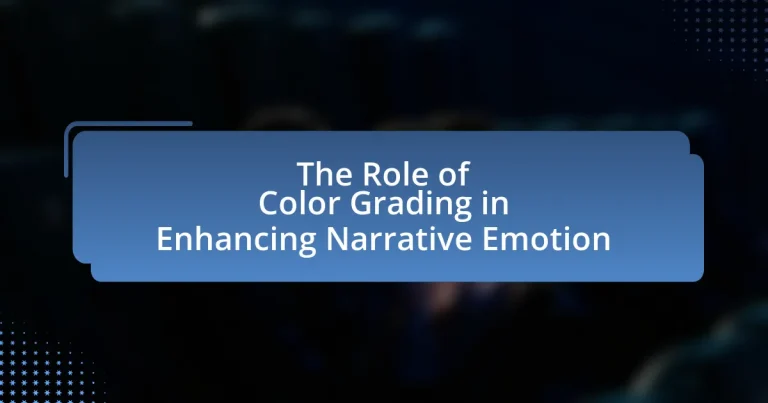The article focuses on the role of color grading in enhancing narrative emotion within film and video production. It explores how color grading manipulates visual tone and mood to evoke specific emotional responses from audiences, supported by research on color psychology. Key topics include the psychological effects of different colors, historical developments in color grading techniques, and the impact of technology on the practice. Additionally, the article discusses best practices for effective color grading, common misconceptions, and the challenges filmmakers face in achieving emotional impact through color.

What is the role of color grading in enhancing narrative emotion?
Color grading plays a crucial role in enhancing narrative emotion by manipulating the visual tone and mood of a film or video. This process involves adjusting the colors, contrast, and brightness to evoke specific feelings and reactions from the audience. For instance, warmer tones can create a sense of comfort or nostalgia, while cooler tones may evoke sadness or tension. Research indicates that color can significantly influence emotional responses; a study published in the journal “Color Research and Application” found that colors can affect mood and perception, reinforcing the emotional context of a narrative. Thus, effective color grading not only supports the storytelling but also deepens the viewer’s emotional engagement with the content.
How does color grading influence the viewer’s emotional response?
Color grading significantly influences the viewer’s emotional response by altering the visual tone and mood of a scene. Through the manipulation of colors, filmmakers can evoke specific feelings; for instance, warm tones often create a sense of comfort and happiness, while cooler tones can evoke sadness or tension. Research indicates that color can affect psychological states; for example, a study published in the journal “Color Research and Application” by researchers from the University of California found that colors like red can increase feelings of excitement, while blue can promote calmness. This demonstrates that color grading is a powerful tool in storytelling, as it directly impacts how audiences perceive and emotionally connect with the narrative.
What psychological effects do different colors have on audiences?
Different colors evoke specific psychological effects on audiences, influencing emotions and perceptions. For instance, red often stimulates feelings of excitement or urgency, while blue tends to promote calmness and trust. Research by Andrew Elliot and Markus Maier in their study “Color and Psychological Functioning: A Review of Theoretical and Empirical Work” (2014) indicates that warm colors like yellow can enhance feelings of happiness, whereas cool colors like green are associated with tranquility and balance. These associations are utilized in various media to enhance narrative emotion, guiding audience reactions and engagement effectively.
How can color grading manipulate mood and tone in visual storytelling?
Color grading can manipulate mood and tone in visual storytelling by altering the color palette and contrast of a scene, which directly influences the audience’s emotional response. For instance, warm colors like reds and yellows can evoke feelings of warmth and happiness, while cool colors such as blues and greens can create a sense of calm or sadness. Research indicates that color can significantly affect perception; a study published in the journal “Color Research and Application” found that specific colors can trigger distinct emotional reactions, reinforcing the idea that color grading is a powerful tool in shaping narrative emotion. By strategically applying color grading techniques, filmmakers can enhance the storytelling experience, guiding viewers’ feelings and interpretations of the narrative.
Why is color grading important in film and video production?
Color grading is important in film and video production because it enhances the visual storytelling by establishing mood, tone, and atmosphere. This process allows filmmakers to manipulate colors to evoke specific emotions and guide the audience’s perception of the narrative. For instance, warmer tones can create feelings of comfort or nostalgia, while cooler tones may evoke sadness or tension. Studies have shown that color can significantly influence emotional responses; for example, research published in the Journal of Experimental Psychology indicates that color affects mood and can alter viewers’ interpretations of scenes. Thus, effective color grading is essential for aligning the visual elements with the intended emotional impact of the story.
What are the historical developments of color grading in cinema?
Color grading in cinema has evolved significantly since the early 20th century, beginning with the use of hand-painted color techniques in silent films like “A Visit to the Seaside” (1908). The introduction of Technicolor in the 1930s revolutionized the industry, allowing for vibrant color palettes in films such as “The Adventures of Robin Hood” (1938). In the 1960s, the advent of color negative film and the development of color timing processes enabled filmmakers to manipulate color during post-production, enhancing visual storytelling. The transition to digital technology in the late 1990s and early 2000s further transformed color grading, with software like DaVinci Resolve allowing for precise control over color correction and grading, thus enabling filmmakers to create specific moods and emotional responses in their narratives. This historical progression illustrates how color grading has become an essential tool in enhancing narrative emotion in cinema.
How has technology changed the practice of color grading?
Technology has significantly transformed the practice of color grading by introducing advanced software tools and digital workflows that enhance precision and creativity. Modern color grading software, such as DaVinci Resolve and Adobe Premiere Pro, allows colorists to manipulate color with unprecedented accuracy through features like color wheels, curves, and LUTs (Look-Up Tables). These tools enable real-time adjustments and non-destructive editing, which were not possible with traditional film grading methods. Additionally, the rise of high dynamic range (HDR) content has expanded the color palette available to filmmakers, allowing for richer and more nuanced visual storytelling. The integration of artificial intelligence in color grading software further streamlines the process by automating repetitive tasks and suggesting color corrections based on learned patterns, thereby increasing efficiency and enabling colorists to focus on artistic decisions.
What techniques are used in color grading to enhance narrative emotion?
Color grading techniques used to enhance narrative emotion include color contrast, saturation adjustments, and color palettes that align with thematic elements. Color contrast helps to create visual tension or harmony, influencing the viewer’s emotional response; for instance, high contrast can evoke feelings of conflict, while low contrast can suggest calmness. Saturation adjustments can intensify or mute colors to reflect the emotional tone of a scene; vibrant colors often convey joy or excitement, while desaturated tones can evoke sadness or nostalgia. Additionally, specific color palettes, such as warm tones for comfort or cool tones for tension, are strategically chosen to reinforce the narrative’s emotional arc, as seen in films like “The Grand Budapest Hotel,” where color choices directly correlate with the film’s emotional shifts.
What are the key tools and software used for color grading?
The key tools and software used for color grading include DaVinci Resolve, Adobe Premiere Pro, and Final Cut Pro. DaVinci Resolve is widely recognized for its advanced color correction capabilities and is used in professional film and television production. Adobe Premiere Pro offers integrated color grading tools that allow for seamless editing and grading workflows. Final Cut Pro is favored by many Mac users for its intuitive interface and powerful color grading features. These tools are essential in the post-production process, enabling filmmakers to enhance visual storytelling through precise color manipulation.
How do color palettes and schemes contribute to storytelling?
Color palettes and schemes significantly contribute to storytelling by evoking emotions and setting the tone of a narrative. For instance, warm colors like reds and oranges can create feelings of warmth or passion, while cool colors such as blues and greens often evoke calmness or sadness. Research indicates that color psychology plays a crucial role in how audiences perceive and connect with a story; for example, a study published in the journal “Color Research and Application” by researchers from the University of California found that color choices can influence viewers’ emotional responses and interpretations of visual media. Thus, the strategic use of color palettes and schemes enhances narrative emotion by aligning visual elements with the intended emotional journey of the story.
How does color grading differ across various genres?
Color grading differs across various genres primarily in its emotional tone and visual style. For instance, horror films often utilize desaturated colors and high contrast to create a sense of unease, while romantic comedies typically employ warm, vibrant hues to evoke feelings of joy and intimacy. Action films frequently use cooler tones and high saturation to enhance adrenaline and excitement. These genre-specific color choices are supported by studies indicating that color can significantly influence viewer emotions and perceptions, such as research published in the Journal of Media Psychology, which highlights how color affects mood and narrative engagement.
What specific color grading techniques are used in horror films?
Horror films commonly utilize specific color grading techniques such as desaturation, high contrast, and the use of cool color palettes to evoke fear and tension. Desaturation reduces the vibrancy of colors, creating a bleak atmosphere that enhances feelings of dread. High contrast emphasizes shadows and highlights, contributing to a sense of unease and unpredictability. Cool color palettes, often featuring blues and greens, can evoke feelings of coldness and isolation, which are effective in horror narratives. These techniques are supported by studies indicating that color significantly influences emotional responses, with research showing that certain color schemes can heighten anxiety and fear in viewers.
How does color grading in romantic films differ from action films?
Color grading in romantic films typically employs warmer tones and softer contrasts to evoke feelings of intimacy and nostalgia, while action films utilize cooler tones and high contrast to create a sense of urgency and excitement. Romantic films often feature pastel colors and golden hues, enhancing emotional connections between characters, as seen in films like “The Notebook,” where the color palette supports the narrative’s emotional depth. In contrast, action films like “Mad Max: Fury Road” use desaturated colors and stark contrasts to heighten tension and adrenaline, aligning with the fast-paced nature of the genre. This differentiation in color grading directly influences the viewer’s emotional response, reinforcing the narrative’s intent in each genre.
What challenges do filmmakers face in color grading for emotional impact?
Filmmakers face several challenges in color grading for emotional impact, primarily including the subjective nature of color perception, technical limitations of software, and the need for consistency across scenes. The subjective nature of color perception means that different viewers may interpret colors differently, which can lead to varied emotional responses. Technical limitations of color grading software can restrict the ability to achieve the desired look, especially when working with low-quality footage or when the original lighting conditions were not optimal. Additionally, maintaining consistency in color grading across different scenes is crucial for narrative coherence, as abrupt changes can disrupt the emotional flow of the story. These challenges necessitate a careful balance between artistic vision and technical execution to effectively convey the intended emotional tone.
How can poor color grading negatively affect a film’s narrative?
Poor color grading can negatively affect a film’s narrative by distorting the intended emotional tone and undermining character development. When color grading is inconsistent or poorly executed, it can create confusion about the story’s mood, leading audiences to misinterpret key scenes. For instance, a horror film may appear less frightening if the colors are overly bright or saturated, diluting the tension and suspense that are crucial for effective storytelling. Additionally, studies have shown that color influences viewer perception; for example, research published in the Journal of Experimental Psychology indicates that color can evoke specific emotional responses, which means poor color choices can directly impact audience engagement and emotional connection to the narrative.
What are common misconceptions about color grading in storytelling?
Common misconceptions about color grading in storytelling include the belief that it is merely an aesthetic choice rather than a narrative tool. Many people think color grading only enhances visual appeal, ignoring its significant role in conveying emotions and themes. For instance, studies show that specific color palettes can evoke particular feelings; warm tones often create a sense of comfort, while cooler tones can induce feelings of sadness or tension. Additionally, some believe that color grading is a straightforward process that can be easily applied, when in reality, it requires a deep understanding of color theory and its psychological impacts on audiences.
What best practices should filmmakers follow for effective color grading?
Filmmakers should follow several best practices for effective color grading, including establishing a clear color palette, using color to enhance storytelling, and maintaining consistency throughout the project. Establishing a clear color palette helps to create a cohesive visual style that aligns with the film’s narrative and emotional tone. For instance, warm colors can evoke feelings of comfort or nostalgia, while cooler tones may convey sadness or detachment. Using color to enhance storytelling involves making deliberate choices that support character development and plot progression; for example, shifting color tones can signify a character’s emotional journey. Maintaining consistency is crucial, as it ensures that the visual experience remains seamless, preventing distractions that could detract from the narrative. Research indicates that color grading can significantly influence audience perception and emotional response, underscoring the importance of these practices in filmmaking.
How can filmmakers ensure consistency in color grading throughout a project?
Filmmakers can ensure consistency in color grading throughout a project by establishing a clear color palette and using reference images. A defined color palette serves as a guideline for the overall aesthetic, helping to maintain visual coherence across different scenes. Reference images, whether from previous projects or color grading samples, provide a benchmark for color tones and moods, ensuring that all shots align with the intended look. Additionally, utilizing color grading software with tools like LUTs (Look-Up Tables) can standardize color adjustments, further promoting uniformity. Studies have shown that consistent color grading enhances viewer engagement and emotional response, reinforcing the narrative’s impact.
What tips can enhance the emotional effectiveness of color grading?
To enhance the emotional effectiveness of color grading, utilize color theory principles to evoke specific feelings. For instance, warm colors like reds and oranges can create a sense of warmth or urgency, while cool colors such as blues and greens can evoke calmness or sadness. Research indicates that color can significantly influence viewer perception and emotional response; a study published in the Journal of Experimental Psychology found that colors can alter mood and emotional states. Additionally, maintaining consistency in color palettes throughout a project reinforces emotional themes and aids in storytelling coherence.


